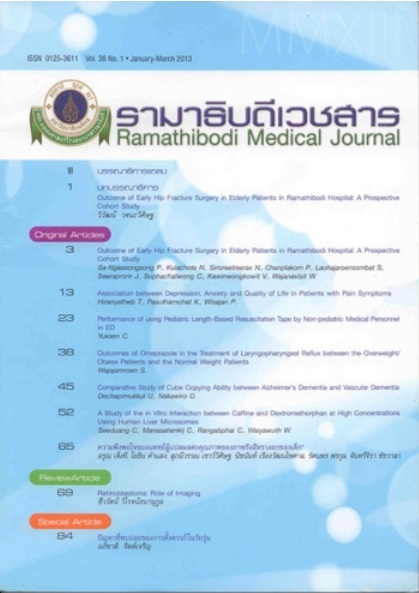A Study of the in Vitro Interaction between Caffeine and Dextromethorphan at High Concentrations Using Human Liver Microsomes
Keywords:
Dextromethorphan, Dextrorphon, In Vitro ExperimentAbstract
Dextromethorphan is dextro-rotatory isomer of synthetical opioid levorphanol. In humans, it is mainly demethylated into dextrorphan after ingestation, by cytochrome P450 via CYP2D6 activity. Dextromethorphan is clinically used as a cough suppressant and exhibits it effect by depressing the medullary cough center in the mid brain. In therapeutic dosage, the drug has no effect on euphoria, pain relief, and also other unwanted toxicities. Unfortunately, dextromethorphan is presently used as an illicit party drug because of its euphoric effect. Dextromethorphan, when used at a dosage over 360 mg in combination with other creative drugs such as Kratom and other sedative drugs, causes the experiences of euphoria and pain relief. The number of abusers has reportedly been increasing in Thailand, and also has been related to several intoxicated deaths. In Thailand, dextromethorphan has been popularly used in a combination with caffeine because caffeine is normally a component in refreshments. In this study, Dextromethorphan and its main metabolite (dextrorphan) were extracted via in vitro reactions by mixed-mode (cation-exchange and reversed-phase) solid phase extraction and measured by gas chromatography and mass spectrometer.
In vitro interaction between dextromethorphan and caffeine was analysed to define its relationship. Metabolization of dextromethorphan (0.1 - 5.0 ug/ml) was significantly inhibited (P < 0.001) by caffeine (10-100 ug/ml) but not for its main metabolite, dextrophan. These results suggest that toxicology of the coexistence of dextromethorphan and a high concentration of caffeine presence produces longer and stronger effects in the human body because the unchanged form of dextromethorphan remains long term while there is a high level of caffeine
References
Abuse of dextromethorphan [database on the Internet]. Available from: https://www.pharmacy.mahidol.ac.th/knowledge/files/0005.pdf.
Schwartz RH. Adolescent abuse of dextromethorphan. Clini Pediatr. 2005;44:565-8.
Elora Hilmas P, Resident PP, Hospital JH. Adolescent dextromethorphan abuse toxalert Maryland Poison Center. 2001;18(1).
Friend of Fecturers. Vol. 10 (issue 3), June-September 2008.
Hasegawa C, Kumazawa T, Uchigasaki S, et al. Determination of dextromethorphan in human plasma using pipette tip solid-phase extraction and gas chromatography-mass spectrometry. Anal Bioanal Chem. 2011;401:2215-23.
Bagheru H. Es-haghi A, Rouini MR. Sol-gel-based solid-phase microextraction and gas chromatography-mass spectrometry determination of dextromethorphan and dextrorphan in human plasma. J Chromatogr B Analyt Technol Biomed Life Sci. 2005;818:147-57.
Statheropoulos M. Tzamtzis N, Mikedi K. Short column gas chromatography-mass spectrometry and principal component analysis for the identification of coeluted substances in doping control analysis. J Chromotogr B Biomed Sci Appl. 1998;706:245-51.
Xu YX, Shen L, Zhang CJ. Analysis of dextromethorphan and its metabolites in human urine by using gas chromatography-mass spectrometry. Yao Xue Xue Bao. 1993;28:156-9.
Baumann P, Jonzier-Perey M. GC and GC-MS procedures for simultaneous phenotyping with dextromethorphan and mephenytoin. Clin Chim Acta. 1988;171:211-22.
Koppel C, Tenczer J, Ibe K. Urinary metabolism of dextromethorphan in man. Arzneimittelforschung. 1987;37:1304-6.
Paup BD, Holler JM, Lyons TP, Past MR. Stable isotopes as valid components for identification of drugs in biological specimens. Analyt Toxicol. 2007;31:447-52.
Yawney J. Development of a general screening method for acidic, neutral, and basic drugs from whole blood using the Oasis HLB Columns and the Oasis MCX Columns: University of Manitoba; 2001.
Evans WE, Relling MV, Petros WP, Meyer WH, Mirro J Jr, Crom WR. Dextromethorphan and caffeine as probes for simultaneous determination of debrisoquin-oxidation and N-acetylation phenotypes in children. Clin Pharmacol Ther. 1989;45(5):568-73.













